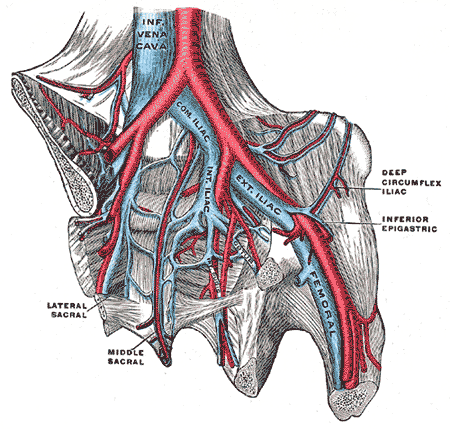The superior vena cava (SVC) and the inferior vena cava (IVC), the largest veins in the human body, are part of the systemic circulation. The SVC and IVC return deoxygenated blood from structures superior (except the lungs and heart) and inferior to the diaphragm, respectively, to the right atrium of the heart. Formed by the junction of the left and right brachiocephalic veins, the SVC extends only a short distance to reach the right atrium. The IVC is formed by the union of the left and right common iliac veins at the level of L5. Extending from L5, the IVC passes through the vena caval foramen of the diaphragm to empty into the right atrium of the heart. The IVC is greater in length than the SVC and has significantly more tributaries draining directly into it.
Due to the brachiocephalic veins being formed by the union of the internal jugular veins and the subclavian veins, the left and right brachiocephalic veins drain deoxygenated blood from the head, neck, and upper limbs into the SVC. The right brachiocephalic vein descends inferiorly, but the left brachiocephalic vein passes at an angle anterior to the branches of the aortic arch. The difference in paths of the left and right brachiocephalic veins is due to the position of the SVC being on the right side of the superior mediastinum just to the right of the trachea. The left brachiocephalic vein is over twice as long as the right brachiocephalic vein due to its extended course. The left brachiocephalic vein not only crosses to the right side of the superior mediastinum, but it must clear the branches of the aortic arch. Formed by the position of the portion of the SVC within the middle mediastinum relative to the ascending aorta is the posterior boundary of the transverse pericardial sinus.
The azygos vein is unique in that it drains directly into the SVC whereas the left and right brachiocephalic veins join to form the SVC. The azygos vein carries deoxygenated blood from the thoracic cage.
The common iliac veins being formed by the union of the internal and external iliac veins. The internal iliac vein receives deoxygenated blood from the gluteal vein, internal pudendal vein, obturator veins, lateral sacral veins, middle hemorrhoidal vein, vesical vein, uterine vein, and vaginal veins. In contrast to the many tributaries of the internal iliac vein, the external iliac vein receives the deoxygenated blood from the femoral vein, deep circumflex iliac vein, and the inferior epigastric vein. Keeping these contributing veins in mind, it is easier to understand that the common iliac veins are moving deoxygenated blood from the gluteal region, external genitalia, pelvic structures, and lower limbs into the IVC. The IVC lies to the right of the abdominal aorta as it ascends retroperitoneally along the right side of the vertebral column. Differences in drainage occur due to the IVC being located on the right side of the body.
Draining directly into the IVC are, from most inferior to most superior, the lumbar veins, ovarian/testicular vein, renal veins, suprarenal vein, hepatic veins, and the inferior phrenic vein. One of the differences in drainage into the IVC occurs with the ovarian/testicular veins. The ovarian/testicular vein on the right side drains directly into the IVC, but ovarian/testicular vein on the left side drains into the left renal vein. Another difference in drainage into the IVC occurs with the suprarenal veins. The right suprarenal vein drains directly into the IVC, but the left suprarenal vein drains into the left renal vein. The deoxygenated blood is drained to the right atrium, where it enters through a semilunar valve which prevents backflow of blood.
There are lumbar veins on each side of the IVC. The lumbar veins receive blood from the epigastric veins, vertebral plexuses, as well as other smaller tributaries. The left lumbar veins are longer than the right because the IVC is on the right side of the vertebral column and because they pass behind the abdominal aorta. The renal veins are large and pass in front of the renal arteries. Passing in front of the abdominal aorta, the left renal vein is longer than the right renal vein and empties into the IVC just above the level of the right renal vein. Due to the differences in drainage previously mentioned the left testicular/ovarian vein, the left inferior phrenic veins, and the left suprarenal vein.
The hepatic veins receive deoxygenated blood from the central veins of the liver. There are two groups that make up the hepatic veins: the upper group and the lower group. The veins of the lower group tend to be smaller than those of the upper group. Lastly, are the inferior phrenic veins which receive deoxygenated blood from the diaphragm. The right inferior phrenic vein empties into the IVC, but the left inferior phrenic vein is sometimes seen with two branches. One of the branches passes through the diaphragm and then empties into the IVC and the other branch empties into either the left renal or the left suprarenal vein.
A. Robinson
Moore, Dalley, Agur: Clinically Oriented Anatomy. 6th ed. Baltimore: Lippincott Williams & Wilkins, 2010.
http://www.dartmouth.edu/~humananatomy/part_4/chapter_24.html
http://www.rci.rutgers.edu/~uzwiak/AnatPhys/Blood_Vessels.html
http://education.yahoo.com/reference/gray/illustrations/figure?id=586
http://www.dartmouth.edu/~humananatomy/part_4/chapter_24.html
http://www.rci.rutgers.edu/~uzwiak/AnatPhys/Blood_Vessels.html
http://education.yahoo.com/reference/gray/illustrations/figure?id=586


Integrity is the lifeblood of democracy. Deceit is a poison in its veins. See the link below for more info.
ReplyDelete#veins
www.ufgop.org